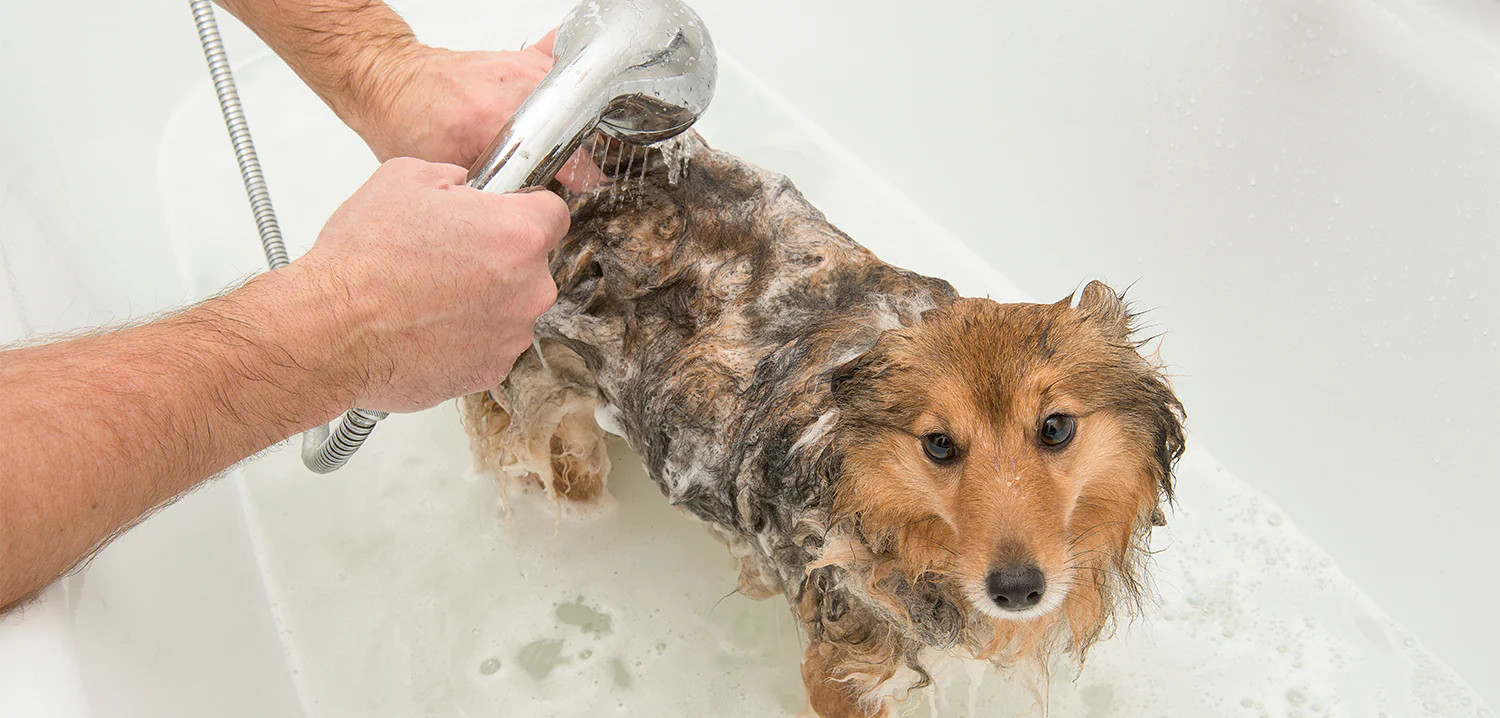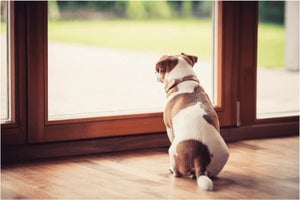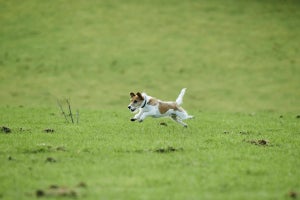
How often should you bathe your dog?
How often your dog needs bathing can vary from pooch to pooch. When determining an appropriate washing schedule, here are five key factors to consider:The breed and coat type. More frequent dog shedding is common with dogs with thick coats or double coats (a warm undercoat and a protective overcoat). Short-haired breeds with single-layer coats tend to shed more fur, so they may need washing more regularly.
Activity level. The more time your dog spends running through woods and ponds getting muddy and dirty, the more frequently baths will be needed. Less active indoor pups may only need occasional washing.
Age.Puppies often need more frequent bathing as they are lower to the ground and exploring their world mouth-first. Meanwhile, older dogs fare better with less frequent full-bath scrubbing.
Skin sensitivity. Dogs with allergies or skin conditions may require customised bathing routines. Check with your vet on special shampoos and how often you should bathe your dog in these cases.
Consider your dog's lifestyle and physical characteristics for a suitable bathing schedule.
How do I know when my dog needs a bath?
You can tell it's time to bathe your dog when you notice unpleasant odours, dirt buildup, or skin irritation. Typically, a bath is due every 4-8 weeks.
Knowing exactly when your dog is due for a bath requires paying attention to certain signs:
Odour. If an unpleasant "doggy smell" arises, it's a clear indicator a bath is needed. A typical wet dog aroma but a pungent body odour suggests more frequent washing.
Visible dirt. Mild dirt from outdoor play can be managed by spot cleaning, but a buildup of mud or debris in the coat means it's time for a deep clean!
- Skin issues. Excessive licking, chewing, flaking, or redness indicates skin irritation that warrants medicated dog grooming shampoos. Consult your vet on underlying causes to manage discomfort.
While most pets need bathing every few months, observing physical and behavioural feedback is key. Smelly, dirty, or itchy dogs require more frequent baths unless it's the bathing that's causing the itchiness. With any skin condition, it's important to seek veterinary advice.
Dog bathing tips and techniques
As a pet parent, making bath time pleasant for you and your dog is possible with the right approach. Follow these tips:
- Positive reinforcementGive treats and praise throughout to associate bathing with good feelings. This makes future washing easier.
- Gradual exposure:Introduce bathing slowly, especially for puppies or rescue dogs that are uneasy with handling. Brief, playful exposures help them become accustomed to the tub.
- Treats and toysYou can always have their favourite squeaky toy or treat handy to serve as positive distractions during the bath.
- Warm waterSticking with lukewarm water is always the best way to go because extreme temperatures make bathing unenjoyable. You can test the water with your wrist before you do anything. It also helps to use a non-slip mat so that the dog feels safe standing in a bath or shower without slipping over.
- Gentle scrubbingIt would help if you used a soft touch and massage shampoo rather than harsh scrubbing, which can irritate your pet's skin.
- RinsingThorough, complete rinsing is really important. Dog owners must understand that allowing soap residue or shampoo buildup to remain on your dog's skin and coat can cause irritation, itchiness, or even dryness and flaking.
- DryingTake extra care when patting your dog's wet coat with a towel after a bath. Avoid violent, harsh rubbing that can damage hair and skin. Instead, gently blot and pat, applying very light pressure. Brace yourself because your dog will first try to shake to remove the water from its coat.With affection, patience, and a few tricks like treats, you can make bath time a stress-free experience for you and your dog.
Bathing techniques for different coat
Bathing methods can vary depending on your dog's unique coat.
Long-haired breeds
For long-haired breeds, it's important to put in some preparatory work before bathing by gently combing through any tangles in the coat.
Making use of a detangling spray can help ease this process. When washing, thoroughly lather the shampoo down the full length of the hair to the skin, ensuring dirt is lifted from the underlayers near the roots. Rinse very thoroughly after shampooing to prevent residue buildup.
Short-haired breeds
For short-haired breeds, their coat texture allows for more vigorous washing techniques.
Massaging the shampoo deeply into the skin and follicles is an effective way to lift dirt and debris from simple, thinner coats. When rinsing, using a slightly stronger water pressure is also fine.
Hypoallergenic breeds
For hypoallergenic dogs or breeds with sensitive skin who are prone to reactions, choose only the gentlest cleansing shampoos and medicated formulas tailored for allergy-prone skin.
How often should you shampoo your dog?
Most dogs only require a thorough shampooing every eight weeks. More frequent shampooing can strip away essential oils and upset the skin's pH balance.
Regarding general upkeep, limit full washes with shampoo to once every one or two months. The powerful cleansers in shampoo remove dirt and wash away beneficial natural oils that protect the skin and coat.
Over-shampooing can often lead to dry, itchy skin. However, exceptions like medicated shampoos to treat infections may require more frequent as per veterinary advice.
Pet parents should consider their dog's breed, coat, activity level, and skin conditions to determine an appropriate shampooing schedule.
However, for the average adult canine, aiming for bathtime once every month or two is a good baseline for maintaining skin and coat health while keeping them clean.
The common concern of over-bathing in dogs
As a pet owner, you might have typed on Google ''How often should I bathe my dog''? You got a lot of answers, and even some went on to point out concerns about over-bathing in dogs.
While it may seem harmless, overbathing your dog too frequently can inadvertently cause damage. Frequent shampooing strips away protective essential oils that keep your dog's skin naturally healthy and moisturised. Even well-meaning pet parents can use frequent bathing to disrupt their dog's skin balance.
Removing these defensive oils before they've had time to replenish leaves the skin dry, itchy, and vulnerable to inflammation or infection. Issues like dandruff, seborrhea dermatitis, eczema, or bacterial folliculitis set in, which require medication and veterinary care.
To prevent over-bathing and the many skin complications it brings, stick to the minimum guidelines between full shampoo baths. Shampoo every few months, depending on your dog's skin sensitivity and how rapidly their coat accumulates dirt and odours.
If you've got a dog prone to dry or flakey skin, bathing them less frequently might help.
Bathing puppies vs. adult Dog
Some distinctions exist between bathing puppies and adult dogs. A puppy's developing skin and coat are vulnerable to damage from overwashing or harsh products.
Their temperature regulation also struggles when wet. You'll have to use only gentle shampoos and warm water, working lather in softly with light fingertips to avoid irritation.
And, when it's time to give them a rinse, do it thoroughly but very gently. Introduce bathing in brief sessions.
For mature dogs, regular shampoos and vigorous rinsing are tolerated because that's something their tough skin and fur can handle.
But that doesn't mean pet parents shouldn't use reasonable care to avoid overdrying. The keys are using age-appropriate shampoos and gentle procedures to prevent trauma during this essential process.
Conclusion
Knowing exactly how often to bathe your dog is crucial when balancing cleanliness and skin health. Though most adult dogs need shampooing only every two months, bathe your dog if its coat seems dirty or oily.
Smelly, dirty, or itchy dogs need washing regardless of their last bath. Adjust bathing frequency for age, coat type, skin sensitivity, and breed while using appropriate gentle techniques.
You should gradually introduce baths to puppies to avoid trauma and only increase them for medical shampoos if a vet advises it, maybe to treat infections or dandruff in dogs.
With mindful bathing schedules catered to your dog's needs and age, you can keep them fresh and healthy while nurturing clean fur and skin.
Frequently Asked Questions
Is it OK to bathe a dog once a week?
No, you can only do this if a vet has advised you. Only veterinarian-approved shampoo and conditioner should be used in such cases. Over-bathing can dry out skin and coat.
How often should you wash your dog UK?
According to vets, most dogs only require bathing every 6 to 8 weeks unless they get particularly dirty from outdoor play. Breed, coat type, age, and skin sensitivity help determine how often you should wash your dog in the UK.
How often should you shampoo your dog?
Veterinarians advise shampooing dogs only when visibly dirty or smelly. When you apply shampoo too often, it could strip protective body oils. You should focus on drying thoroughly and brushing out dead hair between baths.
How do I know when my dog needs a bath?
Obvious dirtiness, persistent doggy odour despite brushing, excessive shedding, or oily skin and coat indicate your pooch likely needs a bath to freshen up. Let your nose guide you!

Related Articles








